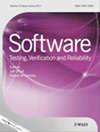VaaS体系结构中多租户应用的验证代数
IF 1.2
4区 计算机科学
Q3 COMPUTER SCIENCE, SOFTWARE ENGINEERING
引用次数: 1
摘要
为了减少多租户体系结构(MTA)中需要验证的组件组合的数量,本文提出了一个代数系统——验证代数(VA)。MTA是一种用于SaaS (Software - as - a - Service)的设计架构,租户可以通过集成已经存储在SaaS数据库中的服务或新提供的服务来定制其应用程序。与SaaS类似,VaaS (Verification - as - a - Service)是一种云中的验证服务,它利用云环境提供的自动配置、可扩展性和服务组合的计算能力。然而,在VaaS体系结构中,存在一个具有挑战性的问题,即“组合爆炸”,即即使使用云计算资源,也难以验证由大量组件和各种组合结构构成的大量组合。本文在已有结果的基础上,提出了组合状态显现规则,以备将来验证。在VA规则中考虑和分析了组合模式和性能。本文章由计算机程序翻译,如有差异,请以英文原文为准。
Verification algebra for multi‐tenant applications in VaaS architecture
This paper proposes an algebraic system, verification algebra (VA), for reducing the number of component combinations to be verified in multi‐tenant architecture (MTA). MTA is a design architecture used in SaaS (Software‐as‐a‐Service) where a tenant can customize its applications by integrating services already stored in the SaaS databases or newly supplied services. Similar to SaaS, VaaS (Verification‐as‐a‐Service) is a verification service in a cloud that leverages the computing power offered by a cloud environment with automated provisioning, scalability and service composition. In VaaS architecture, however, there is a challenging problem called ‘combinatorial explosion’ that it is difficult to verify a large number of compositions constructed by both quantities of components and various combination structures even with computing resources in cloud. This paper proposes rules to emerge combinations status for future verification, on the basis of the existing results. Both composition patterns and properties are considered and analysed in VA rules.
求助全文
通过发布文献求助,成功后即可免费获取论文全文。
去求助
来源期刊

Software Testing Verification & Reliability
工程技术-计算机:软件工程
CiteScore
3.70
自引率
0.00%
发文量
34
审稿时长
>12 weeks
期刊介绍:
The journal is the premier outlet for research results on the subjects of testing, verification and reliability. Readers will find useful research on issues pertaining to building better software and evaluating it.
The journal is unique in its emphasis on theoretical foundations and applications to real-world software development. The balance of theory, empirical work, and practical applications provide readers with better techniques for testing, verifying and improving the reliability of software.
The journal targets researchers, practitioners, educators and students that have a vested interest in results generated by high-quality testing, verification and reliability modeling and evaluation of software. Topics of special interest include, but are not limited to:
-New criteria for software testing and verification
-Application of existing software testing and verification techniques to new types of software, including web applications, web services, embedded software, aspect-oriented software, and software architectures
-Model based testing
-Formal verification techniques such as model-checking
-Comparison of testing and verification techniques
-Measurement of and metrics for testing, verification and reliability
-Industrial experience with cutting edge techniques
-Descriptions and evaluations of commercial and open-source software testing tools
-Reliability modeling, measurement and application
-Testing and verification of software security
-Automated test data generation
-Process issues and methods
-Non-functional testing
 求助内容:
求助内容: 应助结果提醒方式:
应助结果提醒方式:


